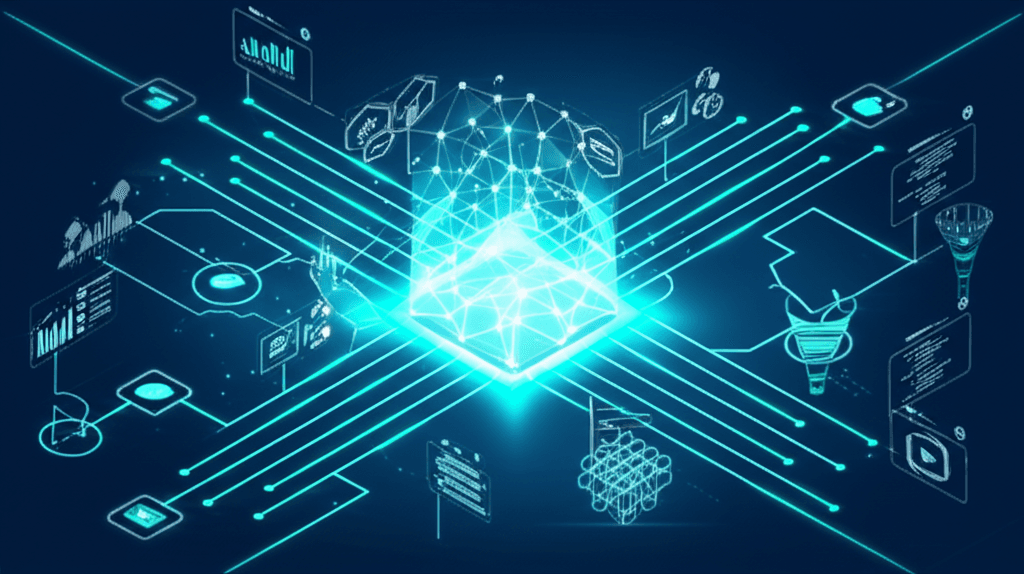Generative AI Becomes Indispensable: Enterprises Integrate AI Into Core Operations
From experimental to essential: Generative AI's 2025 transformation focuses on enterprise integration, data strategy, and real-world efficiency.
August 6, 2025

Generative artificial intelligence is rapidly moving beyond its experimental phase, entering a period of refinement and practical application that is reshaping industries. As we look to 2025, the narrative is no longer centered on the novelty of AI-generated content but on the technology's accuracy, efficiency, and deep integration into enterprise workflows. The focus has decisively shifted from what these powerful systems could theoretically do to how they can be reliably and securely applied at scale, marking a new era of maturity for the technology. What is emerging is a clearer understanding of the necessary components to build generative AI that is not only potent but also dependable and integral to daily operations.
A primary trend defining this new phase is the evolution of large language models (LLMs) beyond the simple metric of size. While early development was a race for more parameters, the industry now prioritizes efficiency and reasoning.[1][2] Models are being engineered to be faster, more cost-effective, and capable of more complex reasoning tasks.[3][4] This shift is driven by techniques like Mixture of Experts (MoE), which activates only relevant parts of the model for a given task, and the development of smaller, more specialized models (SLMs) that can run on local devices like smartphones.[1][5] This move towards more compact and efficient models is making real-time AI applications more viable for routine business functions.[3][5] Furthermore, the rise of multimodal models that can process and generate text, images, audio, and video is opening up new possibilities for more intuitive and comprehensive AI interactions.[6][1]
The scaling of data infrastructure and strategy is another critical area of focus for generative AI in 2025. The quality and accessibility of data are paramount for training accurate and reliable models, yet data readiness remains a significant hurdle for many organizations.[7][8] A recent survey revealed that 39% of organizations moving forward with generative AI cite data issues as their top challenge in scaling up.[8] To combat this, businesses are investing in robust data foundations and innovative approaches to integrate AI into their processes.[7] Techniques like Retrieval-Augmented Generation (RAG), which grounds AI-generated responses in real-time, trusted data, are becoming standard practice to reduce hallucinations and improve factual accuracy.[3][9] This focus on data governance is crucial as enterprises look to leverage their proprietary data to create customized and competitive AI experiences.[10]
Perhaps the most significant trend is the widespread enterprise adoption and integration of generative AI into core business processes.[11][12] A survey in early 2025 showed that 78% of organizations reported using AI, a notable increase from the previous year.[13] Companies are moving from isolated experiments to embedding AI into daily workflows across functions like marketing, sales, customer service, and software engineering.[14][15] This integration is being facilitated by the development of AI agents that can autonomously handle complex tasks and workflows.[16][17] However, this adoption is not without its challenges. Many organizations report internal friction and a lack of clear strategy as significant barriers.[18] Successful adoption often requires a phased approach, starting with a single domain to demonstrate return on investment before broader expansion.[11] Moreover, there is a growing emphasis on human-AI collaboration, designing workflows that leverage the strengths of both humans and artificial intelligence to enhance productivity and decision-making.[19][20]
In conclusion, 2025 marks a pivotal year for generative AI as it transitions from a groundbreaking technology to an indispensable enterprise tool. The industry's focus has matured from building the largest models to creating more efficient, accurate, and multimodal systems capable of complex reasoning. Success in this new phase is intrinsically linked to overcoming data scaling challenges through robust data architecture and governance. As enterprises increasingly embed AI into their operational fabric, the emphasis is shifting towards strategic implementation, human-AI collaboration, and demonstrating tangible business value. The journey ahead will involve not just technological advancement but also significant organizational change as businesses learn to fully harness the transformative power of generative AI.
Sources
[1]
[2]
[6]
[7]
[10]
[11]
[12]
[13]
[14]
[15]
[16]
[17]
[18]
[19]